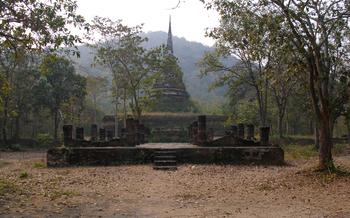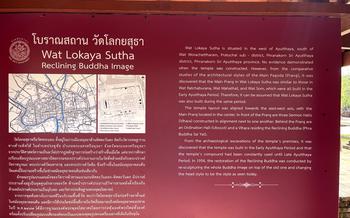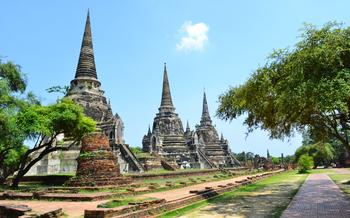
Phitsanulok Historical Park
- Phitsanulok Historical Park: A Journey Through History
- Wat Ratchaburana: A Majestic Temple Complex
- Personal Anecdotes or Experiences
- Phra Buddha Chinnarat: A Revered Buddha Image
- Wat Pho Prathap Chang: A Forest Monastery
- Practical Information for Visitors
- Wat Khao Kho: A Hilltop Temple with Panoramic Views
- Talat Mai Walking Street: A Vibrant Night Market
- Wat Aranyik: A Serene Temple in the Forest
- Insider Tip: Exploring the Local Cuisine
Phitsanulok Historical Park: A Journey Through History
Historical Significance
Nestled in the heart of Phitsanulok, the Phitsanulok Historical Park stands as a testament to the city's rich past. Once the capital of the Ayutthaya Kingdom, Phitsanulok was a thriving center of trade, culture, and religious devotion. The park encompasses the ruins of several ancient temples, palaces, and fortifications, providing a glimpse into the grandeur and significance of this bygone era.
Key Architectural Features and Symbolism
The park's architectural wonders showcase a blend of Khmer and Sukhothai influences. Elaborate carvings, towering spires, and intricate stucco decorations adorn the remaining structures, each element carrying symbolic meanings. The chedis, or stupas, represent the Buddha's relics and teachings, while the naga serpents symbolize protection and guardianship.
Major Attractions Within the Park
Among the park's highlights are Wat Ratchaburana, a majestic temple complex with stunning Buddha images and murals, and Wat Phra Si Ratana Mahathat, a sacred Buddhist site featuring a towering chedi and revered Buddha statues. Phra Buddha Chinnarat, a bronze Buddha image of exceptional beauty, draws countless pilgrims and visitors alike.
Tips for Planning Your Visit
To fully immerse yourself in the park's history and splendor, plan your visit carefully. Arrive early to avoid the midday heat and crowds, and wear comfortable shoes for exploring the grounds. Allocate ample time to wander through the ruins, admiring the intricate details and imagining the lives that once filled these spaces.
Wat Ratchaburana: A Majestic Temple Complex
Wat Ratchaburana stands as a testament to the architectural prowess and religious devotion of the ancient Thai people. Built in the 15th century, this temple complex exudes an air of grandeur and spirituality that captivates visitors from around the world.
The temple's most striking feature is its towering prang, or spire, which rises majestically towards the sky. Adorned with intricate carvings and colorful tiles, the prang symbolizes the sacred Mount Meru, the mythical abode of the gods in Buddhist cosmology.
Inside the temple, visitors can marvel at the exquisite murals that adorn the walls. Depicting scenes from the life of Buddha and other Buddhist stories, these murals offer a glimpse into the rich artistic traditions and religious beliefs of the past.
Wat Ratchaburana is not only a historical and architectural masterpiece but also a place of deep religious significance. The temple houses several Buddha images, including a large bronze Buddha that is believed to date back to the 13th century. Devotees come from far and wide to pay homage to these sacred images and seek blessings for their lives.
Personal Anecdotes or Experiences
During my visit to Wat Ratchaburana, I was struck by the temple's serene and spiritual atmosphere. As I walked through the complex, I couldn't help but feel a sense of awe and wonder at the beauty and craftsmanship that had gone into its creation.
I spent a long time admiring the intricate details of the murals, which seemed to come alive before my eyes. The stories they told were both captivating and inspiring, and I found myself lost in contemplation of the deeper meanings and symbolism behind them.
As I sat in quiet meditation before the large bronze Buddha, I felt a deep sense of peace and tranquility wash over me. In that moment, it felt as if time stood still and all the worries and distractions of the outside world melted away.
Wat Ratchaburana is a truly special place that offers visitors a unique opportunity to connect with the history, culture, and spirituality of Thailand. It is a place that I will never forget and that I highly recommend to anyone who is interested in exploring the wonders of this beautiful country.
Phra Buddha Chinnarat: A Revered Buddha Image
Among the many treasures of Phitsanulok Historical Park, Phra Buddha Chinnarat stands as a masterpiece of Buddhist art and a symbol of cultural heritage. Its historical origins are shrouded in mystery, but legends attribute its creation to a renowned artisan named Phraya Phichai, who is said to have been divinely inspired during its crafting.
Unique Characteristics and Craftsmanship
Phra Buddha Chinnarat is renowned for its exquisite craftsmanship and unique characteristics. Carved from a single block of bronze, the image exudes an aura of serenity and grace. Its elongated and slender proportions, combined with delicate facial features and a gentle smile, embody the ideals of beauty and perfection in Thai Buddhist art. The intricate detailing on the robe, the serene expression, and the graceful hand gestures further enhance the image's allure.
Religious Significance and Reverence
Phra Buddha Chinnarat holds a deeply significant place in Thai culture and is revered by Thai people throughout the country. It is believed to possess sacred powers and is often associated with miracles and blessings. Devotees flock to the temple to pay homage and seek spiritual guidance. The image is also a symbol of national pride and unity, representing the rich cultural heritage of Thailand.
Personal Reflections and Experiences
Having had the privilege of witnessing Phra Buddha Chinnarat in person, I was struck by its captivating beauty and the palpable sense of reverence that surrounded it. The image seemed to radiate a serene energy that filled the temple space. It was a truly awe-inspiring experience that left me with a profound sense of peace and tranquility.
Wat Pho Prathap Chang: A Forest Monastery
Nestled amidst the serene landscapes of Phitsanulok, Wat Pho Prathap Chang stands as a haven of tranquility and spiritual exploration. This unique monastery, also known as the Elephant Temple, draws visitors with its enchanting blend of natural beauty and religious significance.
The temple's most striking feature is the presence of numerous elephant statues scattered throughout the grounds. These majestic creatures, revered in Thai culture for their strength and wisdom, symbolize the path to enlightenment and serve as reminders of the importance of compassion and mindfulness.
Beyond the elephant statues, Wat Pho Prathap Chang offers visitors a glimpse into the lives of Buddhist monks. Meditation caves provide secluded spaces for contemplation and self-discovery, while serene gardens invite visitors to find solace amidst the tranquil surroundings.
Practical Information for Visitors
-
Guided Tours: Guided tours are available for those seeking a deeper understanding of the temple's history and significance. These tours provide insights into Buddhist practices and the lives of the monks residing at Wat Pho Prathap Chang.
-
Meditation Retreats: For those seeking a more immersive experience, meditation retreats are offered at the temple. These retreats provide an opportunity to learn meditation techniques, practice mindfulness, and connect with the spiritual teachings of Buddhism.
-
Visitor Etiquette: Visitors are expected to dress respectfully and maintain silence within the temple grounds. Photography is allowed, but it is essential to be mindful of the privacy of the monks and other visitors.
Wat Khao Kho: A Hilltop Temple with Panoramic Views
Perched atop a picturesque hill, Wat Khao Kho commands breathtaking panoramic views of the surrounding landscape. This serene temple offers a tranquil retreat for visitors seeking spiritual fulfillment and stunning vistas. Its history is deeply entwined with local beliefs and legends, adding to its allure.
The temple's most prominent feature is its towering Buddha image, which exudes an aura of tranquility and reverence. The intricate details and serene expression of the Buddha captivate visitors, inviting them to pause and reflect. Alongside the Buddha image, naga sculptures, mythical serpent-like creatures, adorn the temple grounds, adding a touch of mystical charm to the surroundings.
Visiting Wat Khao Kho during sunset is highly recommended. As the sun descends, the sky transforms into a canvas of vibrant hues, casting a golden glow upon the temple and the surrounding hills. The panoramic views become even more breathtaking, creating a magical ambiance that lingers in the memory.
For those seeking a moment of tranquility, Wat Khao Kho offers a serene environment conducive to meditation and contemplation. The temple's elevated location provides a sense of detachment from worldly distractions, allowing visitors to connect with their inner selves and find solace amidst the natural beauty.
Talat Mai Walking Street: A Vibrant Night Market
As the sun sets over Phitsanulok, a different kind of magic comes alive – the bustling Talat Mai Walking Street. Located in the heart of the city, this vibrant night market is a must-visit for anyone seeking a taste of local culture and culinary delights.
Stroll along the narrow lanes and immerse yourself in the lively atmosphere, where vendors proudly display their wares under colorful canopies. The air is filled with the tantalizing aromas of grilled meats, sweet desserts, and exotic fruits.
Foodies will be in paradise here, with a vast array of street food stalls to choose from. Sample the legendary boat noodles, renowned for their rich broth and tender beef, or indulge in the crispy goodness of fried chicken, a local favorite. Don't miss the chance to try the refreshing mango sticky rice, a perfect blend of sweet and tangy flavors.
Beyond the food, Talat Mai Walking Street is a treasure trove of unique souvenirs and handicrafts. From intricate silver jewelry and handwoven textiles to quirky souvenirs, you're sure to find something to take home as a memento of your trip.
To fully experience the local culture, don't be afraid to engage with the friendly vendors. They're always happy to share stories about their products and recommend hidden gems you might otherwise miss.
Remember to bring cash as most vendors don't accept credit cards. And, of course, come with an empty stomach and an open mind, ready to embrace the vibrant energy and culinary adventures that await you at Talat Mai Walking Street.
Wat Aranyik: A Serene Temple in the Forest
Nestled amidst lush greenery and towering trees, Wat Aranyik offers a tranquil retreat for those seeking spiritual solace. The temple's serene atmosphere and natural surroundings create an ideal setting for meditation and contemplation.
Founded in the 19th century, Wat Aranyik holds a special place in the hearts of local Buddhists. Its reputation for tranquility and spiritual energy has attracted visitors from near and far. The temple's unique architecture and serene ambiance provide a sanctuary for those seeking inner peace and spiritual growth.
One of the temple's most striking features is its beautiful ordination hall, which is adorned with intricate carvings and colorful murals depicting scenes from Buddhist mythology. The hall serves as a sacred space for monks to undergo ordination ceremonies, a significant rite of passage in the Buddhist tradition.
Visitors to Wat Aranyik can explore the temple's peaceful grounds, which feature a variety of Buddha images, meditation caves, and prayer halls. The temple's serene atmosphere and natural beauty make it an ideal place to escape the hustle and bustle of everyday life and find inner peace and tranquility.
Insider Tip: Exploring the Local Cuisine
Phitsanulok is a culinary paradise, boasting a diverse range of local delicacies that tantalize the taste buds. To truly immerse yourself in the city's culinary scene, venture beyond the tourist traps and seek out authentic Thai restaurants frequented by locals.
Must-Try Dishes
-
Boat Noodles (Kuay Tiew Ruea): Savor the flavors of these delicious noodles, prepared in small boats and served with a variety of toppings.
-
Sukhothai Noodles (Kuay Tiew Sukhothai): Delight in the unique flavors of these noodles, characterized by their rich peanut sauce.
-
Grilled Chicken with Sticky Rice (Gai Yang Khao Neeo): Experience the perfect combination of succulent grilled chicken and fragrant sticky rice.
-
Northern-Style Sausage (Sai Oua): Indulge in the spicy and flavorful northern Thai sausage, often served with sticky rice or fresh vegetables.
Navigating Local Markets
To truly experience the local cuisine, visit the vibrant markets where vendors sell fresh ingredients and delicious street food. Be prepared to embrace the hustle and bustle, and don't be afraid to try new things.
Tips for Communicating with Vendors
-
Learn a Few Basic Thai Phrases: Mastering a few basic Thai phrases, such as "hello" (sa-wat-dee) and "thank you" (kop-kun-ka), can go a long way in showing respect and appreciation.
-
Use Hand Gestures: Hand gestures can be a helpful way to communicate when language is a barrier. Pointing to dishes or using hand signals to indicate quantity can be effective.
With an open mind and a willingness to embrace new flavors, you'll discover that Phitsanulok's culinary scene is an adventure waiting to be savored.




